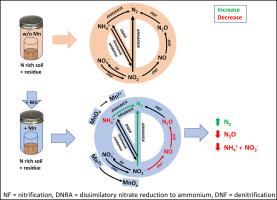锰浓度影响农业土壤氮循环
IF 5
2区 农林科学
Q1 SOIL SCIENCE
引用次数: 0
摘要
锰(Mn)可以调节土壤中氮(N)的转化,但其在农业生态系统中的作用仍未得到充分研究。我们在长期N历史不同的农业土壤中进行了51天的微观培养(N0,未添加N; N1,添加225 kg N ha - 1,持续27年),并用0 (M0)、50 (M1)或250 (M2) mg kg - 1的可溶性Mn和纹状甘油(Lam.)残留物进行了修正。在N1土壤中,Mn的添加(M1和M2)在第51天使总矿物氮比N1M0降低25%,使51天累积N₂O比N1M0减少32% (N1M1)和42% (N1M2),而N0的影响可以忽略不计。Mn在第15天也抑制了氨氧化细菌在N1M2和N1M0中的amoA基因转录(2.5倍变化)。这种减少可能是由于通过微生物途径,如硝酸盐/亚硝酸盐依赖的锰氧化(NDMO),细菌直接使用添加的Mn2+将硝酸盐(NO3−)和亚硝酸盐(NO2−)还原为N2,或作为Mn依赖的氨氧化(Mnammox),细菌将铵(NH4+)氧化为N2,使用Mn氧化物作为添加的Mn氧化形成的电子受体。其他贡献机制可能包括锰诱导的氮固定化、毒性和微生物群落的变化。这些机制结果表明,背景Mn有效性和氧化还原动力学可以塑造富氮条件下的硝化-反硝化途径。我们强调了原生锰库和氧化还原状态如何有助于解释在农业土壤中观察到的氮损失和温室气体产生的变异性。本文章由计算机程序翻译,如有差异,请以英文原文为准。

Manganese concentration influences nitrogen cycling in agricultural soil
Manganese (Mn) can modulate nitrogen (N) transformations in soil, yet its role in agroecosystems remains understudied. We conducted a 51-day microcosm incubation with agricultural soils differing in long-term N history (N0, no added N; N1, added 225 kg N ha−1 for a duration of 27 years) and amended with soluble Mn at 0 (M0), 50 (M1), or 250 (M2) mg kg−1 and Glyceria striata (Lam.) residue. In N1 soils, Mn additions (both M1 and M2) lowered total mineral N by 25 % relative to N1M0 at day 51 and reduced 51-day cumulative N₂O by 32 % (N1M1) and 42 % (N1M2) vs. N1M0, whereas effects in N0 were negligible. Mn also depressed ammonia-oxidizing bacterial amoA gene transcripts at day 15 in N1M2 vs. N1M0 (2.5 fold change). This reduction was likely due to increased N loss via complete denitrification to N₂ through microbial pathways such as nitrate/nitrite-dependent manganese oxidation (NDMO), where bacteria directly used the added Mn2+ to reduce nitrate (NO3−) and nitrite (NO2−) to N2 or as Mn dependent-ammonia oxidation (Mnammox) where bacteria oxidized ammonium (NH4+) to N2, using Mn oxides as electron acceptors that formed from the oxidation of the added Mn. Other contributing mechanisms may include Mn-induced N immobilization, toxicity, and changes in the microbial community. These mechanistic results indicate that background Mn availability and redox dynamics can shape nitrification–denitrification pathways under N-rich conditions. We highlight how native Mn pools and redox state may help explain observed variability in N losses and greenhouse gas production across agricultural soils.
求助全文
通过发布文献求助,成功后即可免费获取论文全文。
去求助
来源期刊

Applied Soil Ecology
农林科学-土壤科学
CiteScore
9.70
自引率
4.20%
发文量
363
审稿时长
5.3 months
期刊介绍:
Applied Soil Ecology addresses the role of soil organisms and their interactions in relation to: sustainability and productivity, nutrient cycling and other soil processes, the maintenance of soil functions, the impact of human activities on soil ecosystems and bio(techno)logical control of soil-inhabiting pests, diseases and weeds.
 求助内容:
求助内容: 应助结果提醒方式:
应助结果提醒方式:


